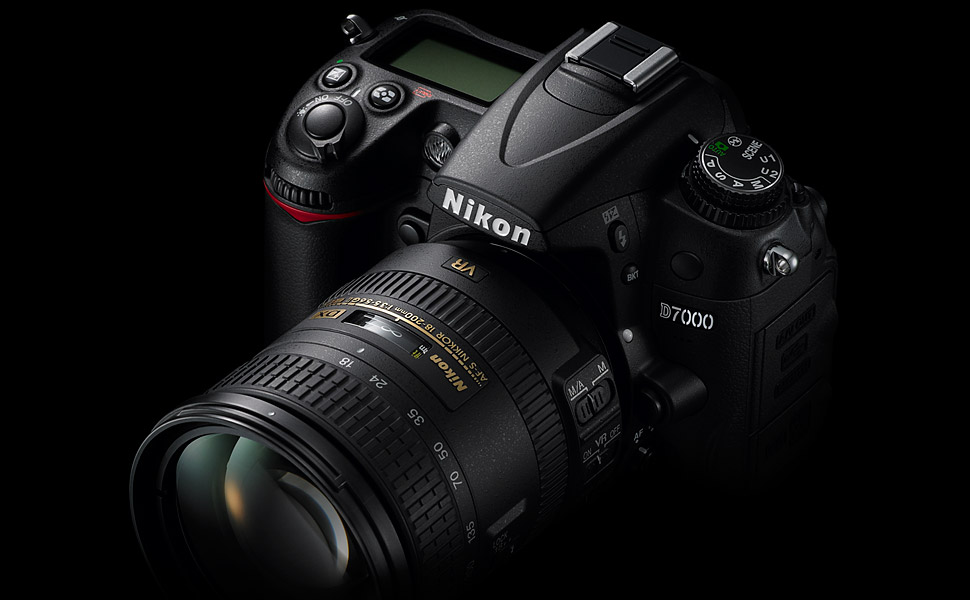
Although ergonomically, the D7000 is a very close match for the D90, its overall 'feel' is considerably more serious, thanks to a magnesium alloy body shell and slightly thicker rubber coating on the hand grip and rear of the camera. At 16.2Mp the D7000 offers the second highest resolution of any Nikon DSLR, behind only the 24Mp D3X. All of these pixels are packed onto a newly developed CMOS sensor, which is almost certainly the same or very similar to that in the Sony Alpha SLT-A55. As well as extra resolution, the new sensor also offers a higher 'standard' ISO span of 100-6400, expandable up to the equivalent of ISO 25,600.
The D7000's AF and metering systems are also new, and represent a significant upgrade to those used in the D90. The new camera boasts a 39-point AF array with 9 cross-type AF points and works in collaboration with a new 2016-pixel RGB metering sensor to allow 3D AF tracking (essentially tracking by subject color, explained here). Other changes include the same combined live view/movie switch control as the 3100, and a significantly upgraded movie specification, up to 'full HD' - 1920x1080 resolution at 24fps. Unlike the D90, the D7000 can also maintain AF during live view and movie shooting, thanks to its AF-F ('full time') AF mode.

D90 owners have been waiting for a replacement camera for a while, and although the D90 isn't set for retirement quite yet, the D7000 certainly represents a compelling upgrade. It took longer than we'd hoped for a production D7000 to be supplied to us, but now that we've had one for a a few weeks we've been able to produce an in-depth review. Read on to find out what we think of Nikon's newest DSLR...
Nikon D7000 Key Features:
- 16.2MP CMOS sensor
- 1080p HD video recording with mic jack for external microphone
- ISO 100-6400 (plus H1 and H2 equivalent to ISO 12,800/25,600)
- 39-point AF system with 3D tracking
- New 2016 pixel metering sensor
- Scene Recognition System (see 2016 pixel sensor, above) aids WB/metering + focus accuracy
- Twin SD card slots
- 3.0 inch 921k dot LCD screen
- New Live View/movie shooting switch
- Full-time AF in Live View/movie modes
- Up to 6fps continuous shooting
- Lockable drive mode dial
- Built-in intervalometer
- Electronic virtual horizon
- Shutter tested to 150K actuations
Nikon D7000 and Nikon D90: Key differences
The D7000 sits above the D90 in Nikon's current lineup, and as befits its new position in the range, the D7000 combines elements of the D90 with elements of the D300S - Nikon's current APS-C flagship. The most obvious physical clue to its new position is a magnesium alloy body shell, which up to now has been reserved for Nikon's top-end APS-C and full frame cameras.
'Under the hood' though the differences are legion - a new 16.2MP CMOS sensor, dual card slots, a new 39-point AF array, 'true' HD movie mode with full-time AF and more customization options, some of which are inherited from Nikon's professional DSLRs. Like the D90, the D7000 supports AF with Nikon's older AF and AF-D lenses (lower-end models are limited to compatibility with AF-S and AF-I optics only) but additionally, because the D7000 has an Ai indexing tab on its lens mount, up to 9 'non-CPU' lenses can also be registered with the camera.
This allows the use of virtually any Ai specification or later lens to be used in aperture priority or manual mode with the D7000, with almost no loss of functionality (apart from AF). Novice DSLR users might never look beyond the horizons offered by their kit lenses, but for the enthusiast, legacy support like this could well be a deal-clincher.
- Higher resolution sensor (16.2MP vs. 12.3MP)
- Choice of 12-bit or 14-bit NEF (RAW)
- 1080p HD movie mode
- Limited movie editing functionality
- AF possible during video shooting
- Live View switch (basically the same as D3100)
- Faster AF in live view mode.
- Twin SD card slots
- Non-CPU lens data function (allows registration of up to 9 non-G lenses with manual apertures)
- Magnesium alloy body shell
- Wider ISO span (100-25,600 including 'H1' and 'H2')
- Newly developed 39-point AF system
- 'Quiet' single frame advance mode
- 'Proper' mirror lock-up (as distinct from 'exposure delay mode')
- Lockable drive mode dial
- Higher maximum frame rate (6fps) with a Continuous Lo shooting option (1-5fps)
- 100% viewfinder
- Choice of 12-bit or 14-bit NEF (RAW) recording in compressed or lossless compressed formats
- Up to 9 'non-CPU' lenses can be registered (same as D300s/D3s/D3X)
- New EN-EL15 lithium-ion battery
- New MB-D11 battery pack (magnesium alloy construction)
See Nikon D7000 16.2MP DX-Format CMOS Digital SLR with 3.0-Inch LCD (Body Only)
No comments:
Post a Comment